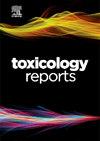Protective effects of Allium sativum essential oil against lead nitrate-induced cardiotoxicity: Modulation of lipid metabolism, nitric oxide dynamics, inflammatory mediators, and histological profiles in Swiss albino mice
Q1 Environmental Science
引用次数: 0
Abstract
Background
Lead (Pb²⁺) is a toxic metal known to induce oxidative stress and inflammation, contributing to cardiovascular diseases such as hypertension and atherosclerosis. Natural compounds like Allium sativum essential oil (ASEO) offer potential therapeutic benefits against lead-induced damage, but their cardioprotective effects remain underexplored. This study investigates the efficacy of ASEO in mitigating cardiovascular toxicity induced by lead nitrate in male Swiss albino mice.
Methods
Thirty-six male mice were divided into six groups: Control, Lead Nitrate (50 mg/kg), Lead Nitrate + Low-dose ASEO (50 mg/kg), Lead Nitrate + High-dose ASEO (80 mg/kg), Lead Nitrate + Silymarin (25 mg/kg), and Lead Nitrate + Olive Oil. After 12 days of lead exposure, treatments were administered for 30 days. Key cardiovascular parameters such as lipid profiles (total cholesterol, LDL, HDL), nitric oxide (NO), and inflammatory markers (TNF-α, IL-6, IFN-γ, IL-10, NF-κB) were evaluated alongside histological analysis of cardiac tissue.
Results
Lead nitrate exposure significantly increased total cholesterol (88.27 µg/mL) and LDL (93.78 µg/mL) while reducing HDL (17.51 µg/mL) compared to controls (P < 0.001). High-dose ASEO lowered total cholesterol (66.07 µg/mL) and LDL (49.62 µg/mL) while increased HDL (27.2 µg/mL) (P < 0.001). NO levels, reduced by lead exposure, were significantly restored by high-dose ASEO (P < 0.001). Inflammatory markers, including TNF-α, NF-kB, and IL-6, were elevated in the lead group but decreased significantly following ASEO treatment (P < 0.001). Histological analysis showed that ASEO markedly preserved myocardial architecture, reducing degeneration and inflammation.
Conclusion
High-dose ASEO demonstrated significant cardioprotective effects against lead-induced toxicity by improving lipid profiles, enhancing NO levels, and modulating inflammatory markers. Further studies are warranted to validate these results.
葱精油对硝酸铅诱导的心脏毒性的保护作用:瑞士白化小鼠脂质代谢、一氧化氮动力学、炎症介质和组织学特征的调节
铅(Pb 2 +)是一种有毒金属,已知会诱导氧化应激和炎症,导致高血压和动脉粥样硬化等心血管疾病。像Allium satium精油(ASEO)这样的天然化合物对铅引起的损伤有潜在的治疗作用,但它们的心脏保护作用仍未得到充分的研究。本研究探讨ASEO减轻硝酸铅对雄性瑞士白化小鼠心血管毒性的作用。方法36只雄性小鼠分为对照组、硝酸铅(50 mg/kg)组、硝酸铅+ 低剂量ASEO (50 mg/kg)组、硝酸铅+ 高剂量ASEO (80 mg/kg)组、硝酸铅+ 水飞蓟素(25 mg/kg)组、硝酸铅+ 橄榄油组。铅暴露12天后,进行30天的治疗。主要心血管参数,如脂质谱(总胆固醇、低密度脂蛋白、高密度脂蛋白)、一氧化氮(NO)和炎症标志物(TNF-α、IL-6、IFN-γ、IL-10、NF-κB)在心脏组织组织学分析的同时进行评估。结果与对照组相比,硝酸铅暴露显著增加了总胆固醇(88.27 µg/mL)和低密度脂蛋白(93.78 µg/mL),降低了HDL(17.51 µg/mL) (P <; 0.001)。高剂量ASEO降低总胆固醇(66.07 µg/mL)和低密度脂蛋白(49.62 µg/mL),升高HDL(27.2 µg/mL) (P <; 0.001)。高剂量ASEO可显著恢复因铅暴露而降低的NO水平(P <; 0.001)。炎症标志物,包括TNF-α、NF-kB和IL-6,在铅组升高,但在ASEO治疗后显著降低(P <; 0.001)。组织学分析显示,ASEO能明显保护心肌结构,减轻退变和炎症。结论大剂量ASEO通过改善脂质、提高NO水平、调节炎症标志物等方式对铅致毒性小鼠具有明显的心脏保护作用。需要进一步的研究来验证这些结果。
本文章由计算机程序翻译,如有差异,请以英文原文为准。
求助全文
约1分钟内获得全文
求助全文
来源期刊

Toxicology Reports
Environmental Science-Health, Toxicology and Mutagenesis
CiteScore
7.60
自引率
0.00%
发文量
228
审稿时长
11 weeks
 求助内容:
求助内容: 应助结果提醒方式:
应助结果提醒方式:


